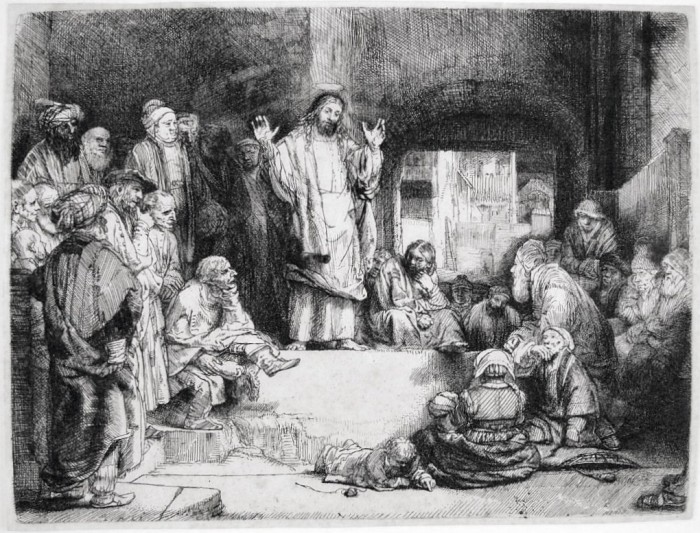Christ Preaching (“La Petite Tombe”) ca. 1657, on Laid Paper

Rembrandt, Harmenz Van Rijn (1606-1669), Christ Preaching (La Petite Tombe), etching, burin and drypoint, c. 1657. References: Bartsch, Hollstein 67, Hind 256, only state; Nowell Usticke’s first state (early) of three, New Hollstein 298, first state (of 2). In excellent condition, with small margins all around, printed on a thin laid paper, 6 1/8 x 8 1/8 inches.
A fine balanced “black sleeve” impression, with strong burr on the drypoint, especially on the sleeve and garment of the man at the left, the garment of Christ, the arch, the wall and column upper right, beard of the man upper left, etc.
Provenance: Gerd Rosen, Berlin, sale 23 (1954), lot 1986
Dr. Otto Schäfer, Schweinfurt (with his stamp verso, not in Lugt) his sale, Sotheby’s New York, May 13, 1993, lot 21
Exhibits (and Publications):
Radierungen von Rembrandt in Ingelheim am Rhein, exhibition Ingelheim 1964, cat. no. 13
Kunst und Können. Drei Graphische Techniken und ihre Meister aus der Sammlung Otto Schäfer, exhibition Martin von Wagner Museum der Universität Würzburg / Städtische Sammlungen Schweinfurt, 1985-86, p. 240, cat. no. R-25, p. 241 ill.
In this print Rembrandt revisits the theme of his magnum opus, the so-called Hundred Guilder Print of ca. 1648 (Bartsch 74). This smaller, condensed version is one of the artist’s most balanced compositions. It has a classical serenity that has led scholars to point to the influence of Raphael’s Vatican fresco of Parnassus. Martin Royalton-Kisch notes that in 1652 Rembrandt sketched a version of Raphael’s work, well-known at the time through reproductive prints, in the album amicorum of his friend Jan Six. After establishing the overall scheme with a straightforward combination of horizontal and vertical elements, the artist enriched the details and atmospheric effects by going over the etched plate with a drypoint needle, thereby creating a lively “dialogue between clean etched lines and velvety drypoint lines fringed with rich burr” (Clifford Ackley, see reference below).
The Petite Tombe has traditionally been dated to ca. 1652. Based on his watermark research Erik Hinterding now proposes an execution date of ca. 1657 (cf. The New Hollstein: Rembrandt. Text, vol. 2, p. 270). Its somewhat confusing title was introduced by Gersaint in 1751 and later mis- understood as making reference to the “little tomb” on which Christ supposedly stands. In fact, this title refers back to Clement de Jonghe’s inventory where it is listed as “Latombisch plaatjen” (La Tombe’s little plate), a reference to Nicholas La Tombe who might have commissioned the work. Members of the La Tombe family are noted in documents relating to Rembrandt dating to between 1650 and 1658.
The early impressions of La Petite Tombe are sometimes referred to as “black sleeve” impressions because of the burr on the sleeve of the man standing left front, which creates a black effect; in later impressions this area whitens. In such impressions there is also burr on the beard of the man in the top left corner, and on Christ’s garments.
Rembrandt printed impressions of La Petite Tombe on both European papers (as in our example) and Japan papers. The latter, which tend to be less absorbent, produce washlike patches of tone where the drypoint burr would otherwise be absorbed by the paper, and the resulting look is painterly, soft and fluid. The European paper impressions have a clearly defined, structural, architectural look. This impression is particularly well balanced, adding to the sense of calm reflectiveness among the listeners (as well as the child playing in the foreground).
literature:
Erik Hinterding, Ger Luijten, and Martin Royalton-Kisch (eds.), Rembrandt the Printmaker, exhibition catalogue, Rijksprentenkabinet, Amsterdam/British Museum, London, 2000–01, no. 68 Clifford S. Ackley et al. (eds.), Rembrandt’s Journey: Painter, Draftsman, Etcher, exhibition catalogue, Museum of Fine Arts, Boston/Art Institute of Chicago, 2003–04, nos. 136f.